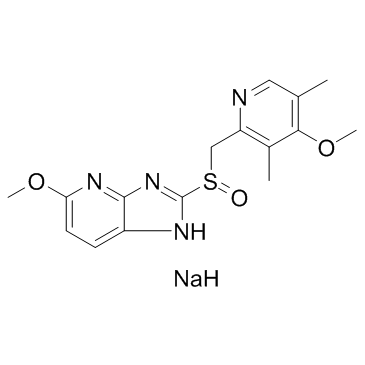Tenatoprazole sodium
Modify Date: 2024-01-14 11:43:01

Tenatoprazole sodium structure
|
Common Name | Tenatoprazole sodium | ||
|---|---|---|---|---|
| CAS Number | 335299-59-7 | Molecular Weight | 369.39 | |
| Density | N/A | Boiling Point | N/A | |
| Molecular Formula | C16H18N4NaO3S | Melting Point | N/A | |
| MSDS | N/A | Flash Point | N/A | |
Use of Tenatoprazole sodiumTenatoprazole sodium (TU-199 sodium) is a proton pump inhibitor; inhibits hog gastric H+/K+-ATPase with an IC50 of 6.2 μM. |
| Name | Tenatoprazole sodium |
|---|---|
| Synonym | More Synonyms |
| Description | Tenatoprazole sodium (TU-199 sodium) is a proton pump inhibitor; inhibits hog gastric H+/K+-ATPase with an IC50 of 6.2 μM. |
|---|---|
| Related Catalog | |
| Target |
IC50: 6.2 μM (H+/K+-ATPase)[1] |
| In Vitro | Tenatoprazole inhibits hog gastric H+/K+-ATPase activity with almost equal potency to that of omeprazole (IC50=6.2 and 4.2 microM, respectively)[1]. Tenatoprazole is a prodrug of the proton pump inhibitor class. Tenatoprazole is converted to the active sulfenamide or sulfenic acid by acid in the secretory canaliculus of the stimulated parietal cell of the stomach. This active species binds to luminally accessible cysteines of the gastric H+/K+-ATPase resulting in disulfide formation and acid secretion inhibition. Tenatoprazole binds at the catalytic subunit of the gastric acid pump with a stoichiometry of 2.6 nmol/mg of the enzyme[2]. |
| In Vivo | Tenatoprazole inhibits basal gastric acid secretion in pylorus-ligated rats in a dose-dependent manner (ED50=4.2 mg/kg p.o.). In gastric fistula rats, tenatoprazole (2.5 and 5 mg/kg i.d.) also inhibits gastric acid secretion stimulated by histamine, carbachol or tetragastrin. Furthermore, tenatoprazole prevents the formation of water-immersion restraint stress-, pylorus ligation- and indomethacin-induced gastric lesions, and mepirizole-induced duodenal ulcer in rats[1]. Maximum binding of tenatoprazole is 2.9 nmol/mg of the enzyme at 2 h after IV administration. The binding sites of tenatoprazole are in the TM5/6 region at Cys813 and Cys822. The bioavailability of tenatoprazole is two-fold greater in the (S)-tenatoprazole sodium salt hydrate form as compared to the free form in dogs[2]. |
| Kinase Assay | The enzyme suspension (20 mg/mL) is incubated at 37°C in a buffer composed of 5 mM Pipes/Tris (pH 6.95), 2 mM MgCl2, 150 mM KCl, 3 mg/mL of valinomycin, 1 mM acridine orange, in the presence of 0.1 mM glutathione, in a SPEX spectrofluorometer for 5 min. Inhibitor (20 mM), omeprazole or tenatoprazole, is added and fluorescence is measured by excitation at 490 nm and emission at 530 nm. After 60 s, ATP (2 mM) is added to initiate acridine orange uptake as a measure of intra-vesicular acidification[2]. |
| Animal Admin | Rats: (R,S)-Tenatoprazole free form (50 mg/kg) or (S)-tenatoprazole sodium salt hydrate (50 mg/kg) is orally administered to dogs and the plasma level of tenatoprazole is measured as a function of time course. Similarly, (S)-tenatoprazole free form (100 mg/kg) or (S)-tenatoprazole sodium salt hydrate (100 mg/kg) is orally administered to dogs and the plasma level of tenatoprazole is measured as a function of time[2]. |
| References |
| Molecular Formula | C16H18N4NaO3S |
|---|---|
| Molecular Weight | 369.39 |
| Storage condition | 2-8℃ |
| EINECS 1592732-453-0 |